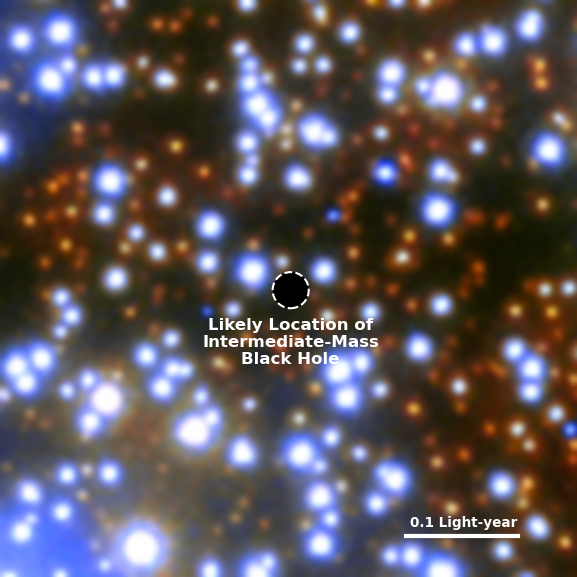The largest of the star clusters that surround the Milky Way, Omega Centauri, has a black hole at the core with a mass 20,000-50,000 times that of the Sun, new evidence reveals. At 18,000 light years away, this object is hardly close, and certainly no threat, but the discovery is important. Astronomers have long sought examples of black holes in this size range to verify models of the universe. The finding also confirms Omega Centauri’s status as the nucleus of a long-gone galaxy.
Known black holes come in two size ranges. There are the remnants of exploded stars with masses less than 100 times that of the Sun, and the great beasts at the heart of galaxies. The lower bound for that latter appears to be around 100,000 solar masses, but most are in the millions or even billions of solar masses range.
Astronomers have put great effort into seeking intermediate black holes, as their presence is needed for our models of how the giants got to their current size. A few likely suspects have been found, but most of the size gap remains. One of the most promising places to look is in dwarf galaxies, but the Magellanic Clouds have yielded no joy.
Omega Centauri is usually described as the largest of the Milky Way’s surrounding globular clusters, but astronomers regard it as having a different history, being what remains of a former dwarf galaxy that got too close to the Milky Way. If, as is suspected its outer stars were stripped to form the Gaia-Enceladus-Sausage components within the Milky Way, that would have frozen any black hole’s growth, leaving it intermediate-sized.

By focusing on the previously marked box we can see Omega Centauri’s beauty, and get closer to the black hole.
Image Credit: ESA/Hubble & NASA, M. Häberle (MPIA)
Omega Centauri also happens to be conveniently close to Earth, by extra-galactic standards, so the possibility of a central black hole has been explored extensively, but results have been debated.
Dr Holger Baumgardt of the University of Queensland thinks that has changed, claiming a team he was part of found the smoking gun. The evidence lies in a handful of stars that are moving at speeds that should be almost impossible without an immense mass nearby. With nothing visible at that location, Baumgardt told IFLScience that a black hole of at least 20,000 solar masses is the only plausible possibility.
The Gaia space telescope has revolutionized our capacity to track the movements of stars within the galaxy, including a few moving at extreme velocities. However, when looking at Omega Centauri, Baumgardt told IFLScience; “There are more than a million stars within a field of view. That’s a real problem for Gaia, the images are far too blurred.” Instead, Baumgardt’s colleagues turned to images taken by the Hubble Telescope over 20 years.
“These images were originally produced to calibrate the Hubble’s instruments rather than for scientific use, but they turned out to be the ideal data set for our research and proved to be invaluable,” Baumgardt said in a statement.
Among Omega Centauri’s ten million stars, seven were found to moving at an angular velocity of at least 2.4 thousandths of an arcsecond per year, as seen from Earth, all close to the cluster’s heart. The angular motion is so tiny most telescopes would be unable to detect it, but at Omega Centuari’s distance it translates to 62 kilometers per second (38.5 miles per second). This would be well above escape velocity for a cluster of stars alone, but a plausible orbiting speed around a large, compact mass.
A slower-moving star closer to us might be mistaken for a faster one further away, and occasionally stars do achieve very high speeds from close encounters with smaller black holes or supernovae. This can throw them out of the galaxy, or in this case galaxy remnant. However, Baumgardt and colleagues calculated we’d be lucky to see one star from either of these categories in the time Hubble has been looking; seven is not credible, particularly packed so close together.

Close up of Omega Centauri where the stars get out of focus and the suspected black hole location can be seen.
Image Credit: ESA/Hubble & NASA, M. Häberle (MPIA)
No strong candidates for black holes have been found in other globular clusters around the Milky Way, emphasizing Omega Centauri’s unusual status. However, some strong suspects have been found in clusters that orbit the Andromeda Galaxy.
Baumgardt told IFLScience that no sign of an accretion disk has been detected from this black hole, but he hopes the findings will stimulate a closer look.
“I think this will invigorate the field and lead to a lot of new research in this area,” he said. “We can begin to speculate how this black hole formed, how it’s related to other massive black holes astronomers have found, and where other intermediate-mass black holes might exist. It’s a thrilling time to be an astronomer and we’re excited to see where our discovery will lead.”
The study is published in the journal Nature.
Source Link: The Closest Black Hole To Us Is Not The One In The Center Of Our Galaxy